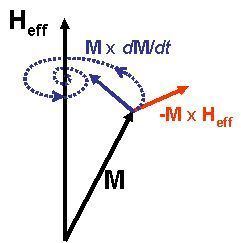 | ||
In physics, the Landau–Lifshitz–Gilbert equation, named for Lev Landau and Evgeny Lifshitz and T. L. Gilbert, is a name used for a differential equation describing the precessional motion of magnetization M in a solid. It is a modification by Gilbert of the original equation of Landau and Lifshitz.
Contents
- LandauLifshitz equation
- LandauLifshitzGilbert equation
- LandauLifshitzGilbertSlonczewski equation
- References
The various forms of the equation are commonly used in micromagnetics to model the effects of a magnetic field on ferromagnetic materials. In particular it can be used to model the time domain behavior of magnetic elements due to a magnetic field. An additional term was added to the equation to describe the effect of spin polarized current on magnets.
Landau–Lifshitz equation
In a ferromagnet, the magnetization M can vary internally but at each point its magnitude is equal to the saturation magnetization Ms. The Landau–Lifshitz–Gilbert equation predicts the rotation of the magnetization in response to torques. An earlier, but equivalent, equation (the Landau–Lifshitz equation) was introduced by Landau & Lifshitz (1935):
where γ is the electron gyromagnetic ratio. and λ is a phenomenological damping parameter, often replaced by
where α is a dimensionless constant called the damping factor. The effective field Heff is a combination of the external magnetic field, the demagnetizing field (magnetic field due to the magnetization), and some quantum mechanical effects. To solve this equation, additional equations for the demagnetizing field must be included.
Using the methods of irreversible statistical mechanics, numerous authors have independently obtained the Landau–Lifshitz equation.
Landau–Lifshitz–Gilbert equation
In 1955 Gilbert replaced the damping term in the Landau–Lifshitz (LL) equation by one that depends on the time derivative of the magnetization:
This is the Landau–Lifshitz–Gilbert (LLG) equation, where η is the damping parameter, which is characteristic of the material. It can be transformed into the Landau–Lifshitz equation:
where
In this form of the LL equation, the precessional term γ' depends on the damping term. This better represents the behavior of real ferromagnets when the damping is large.
Landau–Lifshitz–Gilbert–Slonczewski equation
In 1996 Slonczewski expanded the model to account for the spin-transfer torque, i.e. the torque induced upon the magnetization by spin-polarized current flowing through the ferromagnet. This is commonly written in terms of the unit moment defined by
where
